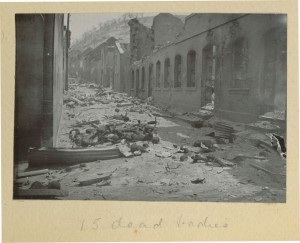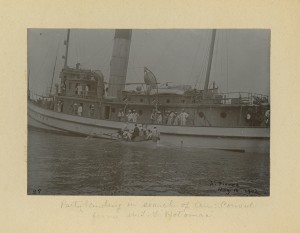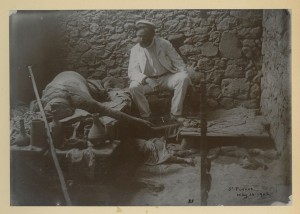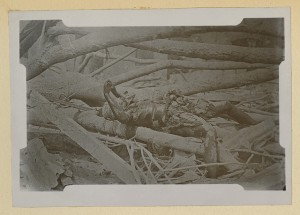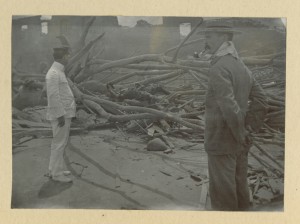Figure 1. View of St. Pierre, Martinique, after Eruption of Mt. Pelée (May 1902), by W. G. Cooper. Unless otherwise indicated, all images courtesy of Southern Methodist University, Central University Libraries, DeGolyer Library (Latin America and the Caribbean: Photographs, Manuscripts, and Imprints).
The devastating 1902 eruption of Mont Pelée—the twentieth century’s deadliest volcanic eruption—coincided with two crucial moments in Caribbean history: a period of incipient modernity in which technological advancements made it possible for events in a previously isolated corner of the world to consume international public attention; and a moment of ambiguity in colonial relations following the Spanish-American War, during which the American burgeoning empire sought to capitalize on British and French preoccupations elsewhere to gain a stronger foothold in the Caribbean region. The fate of Martinique after the destruction of its cultural capital and the death of its nearly 29,000 inhabitants was debated fiercely in the eager correspondence that found its way to London, Washington, and Paris through diplomatic pouches, and even more fiercely perhaps in the international press, all attesting to the understanding that the Martinican eruption had opened a space of contention that could destabilize colonial relations in the Caribbean.
As a result, the aftermath of the tragedy produced a flood of stories that rivaled in volume and scope anything known to the world up to that moment. Witnesses, those who had lost relatives and friends, journalists, scientists, and, for the first time in a tragedy of this magnitude, photographers served as conduits for a multiplicity of narratives about the impact and significance of the devastating event. American correspondents in the post-Spanish-American-War Caribbean responded to the story with unparalleled eagerness, using the tragedy as the means of testing the technical and narrative possibilities of mass communications after the breakthrough represented by the laying of transatlantic and transcaribbean telegraphic cables. Through its coverage of the tragedy, the American press was eager to also test its growing influence in the conduit of the country’s international affairs. In the final decades of the nineteenth century—a period during which American journalism had experienced a sometimes questionable epiphany—the press had grown accustomed to playing a crucial role in shaping public opinion and influencing American foreign and domestic policy, particularly in the Caribbean region during the events surrounding the Spanish-American War. Moreover, in the two decades preceding the Martinican eruption (1880–1900), the number of newspaper titles in the United States had more than doubled, growing from 850 to nearly 2,000. In addition to the weekly papers serving small towns and medium-sized cities, every major city had its own daily, and in large metropolitan centers such as New York, Chicago, and San Francisco, circulation battles had erupted between two or three competing newspapers. Complex, multifaceted stories such as that of the destruction of St. Pierre provided perfect material for these newspaper wars. In countless ways, coverage of the Mont Pelé catastrophe signaled the ways in which the popular US press would approach international reporting during tragic events to come, from the sinking of the Titanic to World War I and beyond.
The destruction of St. Pierre received extensive coverage in the American press—the New York Times, for example, ran more than one hundred stories on the eruption in the month following the tragedy. Coverage needed to be extensive, given the American readership’s fairly complete lack of knowledge of the history, politics, ethnicities, and even location of a French territory whose existence had never before intruded in the American consciousness. Accounts of the tragedy, given the audience’s lack of familiarity with the island, emphasized particularly those beauties—of landscape, seascapes, flora—that would most appeal to the sympathies of newspaper readers, and from the very beginning (particularly in the yellow press) were built on an emphasis on the romance and exoticism of the tropics. The international—and particularly the United States’—reading public, insatiable for details on the destruction and untold deaths stemming from the eruption, consumed a prodigious amount of official reports, newspaper articles, magazine essays, first-hand accounts, published letters, diaries, and sermons. By the close of 1902 there were some forty books and pamphlets in print, many accompanied by the dramatic photographs sold around the world by the Underwood and Underwood Stereographic Company.
I want to focus here, briefly, on the dead of St Pierre, and most particularly on the press’s (and the reading public’s) obsession with the fate and deployment of the bodies of the dead. In the immediate aftermath of the tragedy, and for weeks to come, press reports included dramatic descriptions of the discovery of bodies (or body parts) and of the strong smells of the tens of thousands of cadavers rapidly decomposing in the intense heat of a late Caribbean spring. The public seemed avid for details of the impact of the searing heat of a pyroclastic cloud on human bodies and of the painful process of identification of specific individuals—most of them white and, most compellingly, female. Descriptions like this one from a 12 May 1902 article in the New York Times abounded:
Huge blocks and still hot stones were scattered about. From under one large stone the arm of a white woman protruded. Most notable was the utter silence and the overpowering stench from the thousands of dead. Careful inspection indicated that the fiery stream which so completely destroyed St. Pierre must have been composed of poisonous gases, which instantly suffocated every one who inhaled them, and of other gases burning furiously, for nearly all the victims had their hands covering their mouths or were in some other attitude showing that they had sought relief from suffocation. All the bodies were carbonized or roasted.1
Figure 2. Mt. Pelée: 15 Dead Bodies (1902), by W. G. Cooper.
Narratives of the state of the victim’s bodies were accompanied by what would appear to modern sensibilities as gruesome and overly graphic images of disemboweled and decomposing bodies—like the oft-published image of the carbonized bodies (see fig. 2) found on the Place Bertin. John Taylor, in Body Horror: Photojournalism, Catastrophe and War, writes of broadsheets and tabloids as “dedicated to the value of horror”—its “normal, everyday practice” that of laying before its readers “somewhat restrained pictures taken in public places of bodies in misery, frightened, and grieving, and sometimes at the point of dying or already dead.” The tragedy of Mont Pelée took place in the very early stages of the development of tabloid journalism and represented an early opportunity to grapple with the limits of the depiction of the dead. The industry, which according to Taylor has since learned to “give expression to and confirm ordinary, polite ways of looking—in which readiness to avert the gaze or give no more than a quick glance is considered most acceptable”—struggled to find a middle ground between restraint and the ghastly in its approach to the tragedy of Mont Pelée.2
Written accounts like this 12 May report from Salt Lake City’s Deseret News, for example, described the area around the Custom House as containing hundreds of charred corpses “lying in all kinds of attitudes[,] . . . every vestige of clothing burned . . . and in many cases [with] abdomens . . . burst open by the intense heat,” while weekly magazines added intensely graphic materials to their own descriptions of “grim piles of bodies stacked everywhere.”3 The forbidding task of disposing of the bodies belonged to a contingent of French soldiers, who worked in small detachments to build “enormous pyres of wood and branches of trees, upon which they heaped the bodies by scores, and burned them as rapidly as possible.”4 The US press avidly followed the comings and goings of the government vessel Rubis, which arrived periodically with supplies of firewood and quicklime and quantities of petroleum and coal tar to soak the pyres and prevent the “frightful odor of burning flesh.” The men, as the New York Sun reported, could only work for short periods at a stretch, since “the entire atmosphere [was] so saturated by the stench that the parties were made ill by it.”5
The focus on the press’s descriptions and photographing of the bodies of the dead of St. Pierre offers a very early example of how newspapers (or in more modern terms, the media) would in time serve as a conduit for a daily stream of images of the dead and the dying. In the case of the dead of Mont Pelée, moreover, we find a telling racial divide between the selective sentimentalization of “iconic” white bodies, whose identification and proper burial became the goal of search parties, and the descriptions of massive pyres of the unidentified “native” dead. In the St. Pierre tragedy we can see clearly for the first time in a catastrophe of this magnitude how the US press weighs “the value of a disaster as news by the nationality of its victims,” with the US and European dead emerging as “more newsworthy” than the masses of the local Martinican victims.6 The gap that emerges between the narratives of precious efforts at maintaining the integrity of selected and identifiable white corpses and the gruesome anonymity of the masses of the local dead already points to the modern media’s strategies for manipulating our sympathies through the selection of “representative” individuals with which the public can identify. The publication of explicit photos of the local victims of the Mont Pelée volcano (seen against the restraint applied in the photographing of US and European victims) points to what Roy Greensdale has described recently as a racist “hierarchy of death” in which “the deaths of non-white people in foreign parts . . . are never accorded equal status by the white, western media.”7 In the case of Mont Pelée, this “representativity” is defined in terms of race and gender.
In many of the stories describing the aftermath of the eruption, the tragedy is filtered through the representation in the yellow press of the Martinican nation as a dead or dying white upper-class maiden or matron. These gendered and racialized hierarchies of grief and loss function as baits of public interest, luring readers into an awareness and support for related political and national concerns while obscuring the less compelling truth that the great majority of the dead of St. Pierre were black urban workers and peasants. The reading public—the US public most glaringly—proved itself eager to consume tale after tale of matrons found dead in the rubble (as in the case of Mrs. Prentiss, wife of the American consul in St. Pierre, and her young daughters), of dead European beauties on the threshold of womanhood (like Signorina Paravicino, daughter of the Italian consul to Barbados, whose funeral “beggared description”8), or of the sufferings of the cream of young creole womanhood (the convent students described in an apocryphal account in the throes of horror and anguish as rivers of lava slowly surround and engulf them). The story of the search for the Italian consul’s daughter was found particularly compelling by the public and the young victim’s story emerged as one of the most avidly consumed narrative—perhaps second only to the tale of the search for the bodies of Mrs. Prentiss and her daughters. Reporters from New York’s Sun had followed the distraught Signor Paravicino’s party through the ruins of the city into the small hamlet of Carbet, just a short walk up the coast from Place Bertin, as they searched for the remains of his young daughter, who had been staying with friends at one of the airy residences near the botanical gardens.
The details of their search were gruesomely related in countless newspapers worldwide—only to be rehashed later in almost all of the books written in the immediate aftermath of the catastrophe. The impact of the pyroclastic cloud on the hamlet in which Paul Gauguin had lived and painted a little over a decade before had been more vividly cruel than in other parts of the city, these narratives tell us. Whereas in St. Pierre the victims had been “mostly covered in ashes and other debris,” in Carbet they had found 500 bodies “terribly distorted and in an advanced state of decomposition.” The “wave of fire” had “badly charred” everyone found within the dwellings, including Signorina Paravicino, whose body had to be identified by relatives and friends by its clothing. This detail was invariably followed by scientific musings about “the curious effect of the fire that swept through the town, bodies being burned beyond all recognition, but the clothing of flimsy material being little damaged.”9 A similar phenomenon was observed about furniture, papers, books, and flooring, which appeared unscathed even though the force of the fiery cloud had blown away windows and doors and burned all inhabitants.
I find the absence of photographs of the removal of Signorina Paravicino’s body or of the sad cortege that bore it to the waiting ship for transport to Barbados most revealing, as it perhaps indicates an understanding on the part of the Sun’s team that such photographing would have been unseemly (very likely not allowed or considered a profanation) in the presence of relatives—her father included. No photographs, therefore, exist of one of the most iconic searches for the victims of Mont Pelée. A similar search for the bodies of the US consul and his family produced only a single extant photograph—a long shot of the rowboat bearing the landing search party (see fig. 3). The bodies themselves—although central to the narratives produced for readers—were respectfully concealed from prying eyes. When depicted in the press, for example, the Prentiss family invariably appeared in their official consulate photographs and in press reports were able to “speak” through letters mailed prior to the eruption, which were released to the press by their families.10
Figure 3. Party Landing in Search of Am: [sic] Consul from U.S.S. Potomac, by W. G. Cooper, 14 May 1902.
This absence of photographs of the “iconic” death redeploys our empathy towards the grieving relatives and somber search parties and separates the privileged (and unphotographed) from the masses of the dead whose bodies can be displayed—sometimes callously so.
Figure 4, taken on 14 May—a mere six days after the eruption and by one of the earliest reconnaissance expeditions able to enter the still smoldering city—offers the rather extraordinary image of a rescue team member casually posing for a photograph in a small humble room that contains the bloated bodies of a woman and a young child. Instead of appealing to the viewer’s empathy, compassion, or pity for these victims of the eruption, the composition underscores the anonymity of the faceless, unidentifiable corpses, partially covered by pyroclastic dust and seemingly undeserving of the social rituals of grief and mourning. The image shocks in part because of the central position assumed by the white-clad white man within the frame and the proprietary air with which he occupies a space that is not natural to him—and which signals an “invasion” of the space of death. The result is the outright relegation of the dead—poor and unprivileged former “owners” of the space—into a secondary plane. Previous poverty and deprivation, evident in the reduced dimensions of the room and humble belongings of its now dead occupants, are exacerbated by the volcanic dust now covering every surface, like a symbolic preburial that points to the fact that these bodies are now destined for the anonymous mass pyres.
The image is one that prompts questions about its justification and purpose. Taken by W. G. Cooper, who operated a photography studio in Bridgetown, Barbados, and who produced an album of sixty-one photographs of St. Pierre after the eruption, the purpose for the image seems that of simply recording the central subject’s presence in the space of death—an “I was here” moment in which the bodies of the dead become mere props in the slightly disturbing and invasive scene. (Cooper is believed to have traveled to St. Pierre with the party accompanying Signor Paravicino as he searched for his daughter’s body.) The image effectively dismisses grief (the living occupier of the space is a stranger) and precludes mourning in its objectification of the dead. It reminds us of Dana Luciano’s argument, in Arranging Grief: Sacred Time and the Body in Nineteenth-Century America, that mourning was “a deeply meaningful practice that was vulnerable to erasure by the advancement of history, prefiguring the story that twentieth-century historiography would tell about the displacement of death by modernity.”11
Figure 4. Mt. Pelé: St. Pierre, May 14 1902, by W. G. Cooper.
Equally disturbing are two photos taken the same day—also by W. G. Cooper—and usually used to illustrate the oft-described phenomenon of the bursting of the victim’s lower abdomen to expose the intestines. The dramatic photograph of the corpse lying amidst the debris left by the eruption—with its arms poised as if to ward off the horrific cloud advancing towards him—conveys to the viewer the power of approaching horrific death (fig. 5). Pushed back by the force of the nué ardente, the corpse’s attitude seems emblematic of the catastrophe, “iconic” in its encapsulation of the tragedy. This body could stand for all the bodies—surprised by the force of the pyroclastic cloud, dead in an instant, frozen in terror, the impact on the body itself a testament to the violence of the eruption.
Figure 5. Mt. Pelée: Body, Result of Eruption of Mt. Pelée on Martinique (1902), by W. G. Cooper.
The second image—clearly taken within minutes of the first—frames the same dead and carbonized body between two members of a search party (fig. 6). One of them—a naval officer or colonial official occupying the middle ground—is turned toward the corpse in an attitude conveying interest or respect. The other one—a civilian occupying the foreground—strikes a dapper pose as he looks into the distance while nonchalantly smoking a pipe. The curious juxtaposition of the three figures objectifies the mummified corpse, here relegated to the background, dehumanized as an exhibit. The viewer’s eye follows in zigzagging form from the unmoved subject in the foreground to the observer of the body in the middle ground to the object of his unseen gaze in the background. The trajectory “narrates” the space of the tragedy from the photographer’s own gaze, which ascribes agency to the viewers and relegates the dead to a curiosity, interesting only because of the evidence of the power of the storm it conveys. What is glaringly missing from these photographic “narratives” is precisely what we find in abundance in the tales of the unphotographed Prentiss family or the romanticized Signorina Paravicino—a sense of mourning. The photos create an ambivalent space marked by the absence of concern or a sense of loss. In some of these photos the presence of household objects reminds us of the frequent taking of such objects as souvenirs by the search parties. The overall sense of these photographs is that of the outsiders’ appropriation of spaces and relics—a re-placement of the dead as spectacle that eschews mourning. Roland Barthes, writing about photography, had argued that “a universal silence must fall over all those confronted by photographs of catastrophe,” since “far from being the source of memories and contemplation, enabling grief to turn into mourning,” photography “excludes all purification, all catharsis.”12 This is particularly true of these early images of the Mont Pelée catastrophe, which save grief and mourning for the “narrated” but unphotographed.
Figure 6. Mt. Pelée: Two Men and Body, Result of Eruption of Mt. Pelée on Martinique (1902), by W. G. Cooper.
The tragedy of Mont Pelée—the first natural disaster of the protomodern mass media—emerges from this gap between the photographed and the unphotographed, between the objectified dead and the mourned dead, as an appropriated catastrophe, a resignified tragedy in which only certain individuals are mourned and commemorated. Others, the great mass of the dead, are laid before our eyes in series of photographs and objectified descriptions that thwart the very possibility of mourning. The occupation of the spaces of the dead by the search parties in these photographs represent a problematic form of “witnessing.” Present in St. Pierre as priviledged witnesses to catastrophe, their primary connection seems to be to the camera lens that records their presence in spaces that would become the focus of international obsession at the time. Their occupation of these spaces—captured as it is by the camera lens—becomes arrogant colonizing rather than empathetic concern. Through the lens of the camera, they impose a collective acceptance of a “hierarchy of death” that will become a foundational element of newspaper and media reporting on catastrophes affecting peoples of color since the tragedy of Mont Pelée.
Lizabeth Paravisini-Gebert is a professor of Caribbean culture at Vassar College, where she holds the Randolph Distinguished Professor chair. She is the coauthor, with Margarite Fernández Olmos, of Creole Religions of the Caribbean (2003) and of the forthcoming Jose Martí: A Life. She is currently at work on “Extinctions: Chronicles of Vanishing Fauna in the Caribbean.”
1 “Horrors of St. Pierre: Doomed Inhabitants Were Suffocated, Judging from the Appearance of Corpses,” New York Times, 12 May 1902, 1, 2.
2 -John Taylor, Body Horror: Photojournalism, Catastrophe, and War (New York: New York University Press, 1998), 87.
3 “Thirty Thousand Have Perished,” Deseret News, 12 May 1902, 1.
4 “St. Pierre Horror Revealed: Relief Parties Effect a Landing but Find a City of the Dead—Cremation Resorted To—Desolation Is Complete,” Boston Evening Transcript, 12 May 1902, 2.
5 “Robbing the Dead: Thieves Follow the Burial Parties into St. Pierre,” Sun, 14 May 1902, 1.
6 See Taylor, Body Horror, 90.
7 Roy Greenslade,“A Hierarchy of Death,” Guardian, 19 April 2007, www.guardian.co.uk/commentisfree/2007/apr/19/thirtytwodieinamericanuniv (accessed 12 January 2013).
8 “Robbing the Dead,” 1.
9 Ibid.
10 The portraits of US Consul Thomas Prentiss and his family are included in William Garesché, Complete Story of the Martinique and St. Vincent Horrors: Incidents of the Awful Volcanic Eruption, Fire, and Lava Disaster (New York: L. G. Stahl, 1902), 112.
11 Dana Luciano, Arranging Grief: Sacred Time and the Body in Nineteenth-Century America (New York: New York University Press, 2007), 4.
12 Roland Barthes, Camera Lucida (London: Vintage, 2000), 90–91.

